Living with diabetic neuropathy pain isn’t just about discomfort-it’s about losing control over your daily life. Burning feet at night. Tingling that won’t quit. Aching so bad you avoid walking. And the worst part? Diabetic neuropathy pain doesn’t go away with rest, ice, or over-the-counter pills. It’s nerve damage, and once it’s there, no medication can undo it. But that doesn’t mean you’re stuck suffering. The right combination of medications and foot care can cut your pain by half-or more-and keep you walking, sleeping, and living without fear.
What Medications Actually Work for Diabetic Nerve Pain?
Not all painkillers help with diabetic neuropathy. NSAIDs like ibuprofen? They won’t touch nerve pain-and they can hurt your kidneys, which is dangerous if you have diabetes. Opioids? Risky. The CDC warns they often lead to dependence without lasting relief. So what does work? Four drugs are FDA-approved specifically for this type of pain, and several others are commonly used off-label based on solid evidence.
The most trusted first-line options are duloxetine (Cymbalta) and pregabalin (Lyrica). Duloxetine, a serotonin-norepinephrine reuptake inhibitor (SNRI), works by changing how your brain processes pain signals. It’s taken once daily at 60 mg. Many people notice improvement within two weeks, with full effects by week 8. What makes it stand out? It doesn’t just reduce pain-it also lifts mood. About 1 in 3 people with diabetic neuropathy also have depression, and duloxetine helps both. Side effects? Nausea, dry mouth, and sometimes weight gain. But for many, the trade-off is worth it.
Pregabalin is a gabapentinoid that calms overactive nerves. It’s taken in divided doses, usually 75-150 mg daily. It works fast-some feel relief in 48 hours. But it comes with a cost: dizziness in 3 out of 10 users, sleepiness in 1 in 5. It’s also expensive, even as a generic. A 90-capsule supply can run $379. That’s why many start with gabapentin instead. It’s the same class of drug, works similarly, and costs as little as $4 for 90 capsules. Doses range from 300 mg to 3,600 mg daily, split into three doses. The downside? You have to titrate slowly to avoid dizziness. Most people need 6-8 weeks to find their sweet spot.
Then there’s the 8% capsaicin patch (Qutenza). This isn’t a pill-it’s a treatment applied by a doctor in a clinic. It uses concentrated chili pepper extract to deplete pain signals from nerve endings in your feet. One 60-minute application can reduce pain for up to 3 months. The catch? The application hurts. You’ll feel a burning sensation during the procedure. But patients who stick with it often report 60-70% pain reduction. Reddit users call it a game-changer-even if the process feels like torture.
Tricyclic antidepressants like amitriptyline are still used, even though they’re not FDA-approved for neuropathy. They work by blocking pain signals in the spinal cord. Doses are low-10 to 50 mg at bedtime. They’re cheap, effective, and help with sleep. But side effects are harsh: dry mouth, constipation, blurred vision, and drowsiness. For older adults or those with heart issues, they’re risky. A 2022 study found 22% of patients quit TCAs because the side effects were worse than the pain.
Why Some Medications Fail-and What to Do Next
Here’s the hard truth: no single drug works for everyone. In fact, only 30-50% of people get meaningful pain relief from any one medication. That’s not failure-it’s normal. Treatment is a process of trial and error. Doctors don’t guess. They test.
Start low, go slow. If you’re prescribed duloxetine, begin at 30 mg daily for a week. Then increase to 60 mg. If you get dizzy or nauseated, stay at 30 mg longer. If pregabalin makes you feel like you’re walking through molasses, drop to 25 mg twice a day. Give each medication at least 6-8 weeks before deciding it doesn’t work. Many people quit too soon.
If one drug fails, try another class. Switch from gabapentin to duloxetine. Or add a topical lidocaine patch (Lidoderm) to your routine. These patches are applied directly to painful areas and block local nerve signals without systemic side effects. They’re great for localized foot pain.
For those who’ve tried everything and still hurt, combination therapy helps. A 2022 study in Neurology found that adding N-acetylcysteine to pregabalin boosted pain relief significantly. Clinical trials for new drugs like mirogabalin (expected FDA approval in 2025) and nerve growth factor blockers are underway. But for now, the goal isn’t total pain elimination-it’s getting to a level where you can sleep, walk, and live.
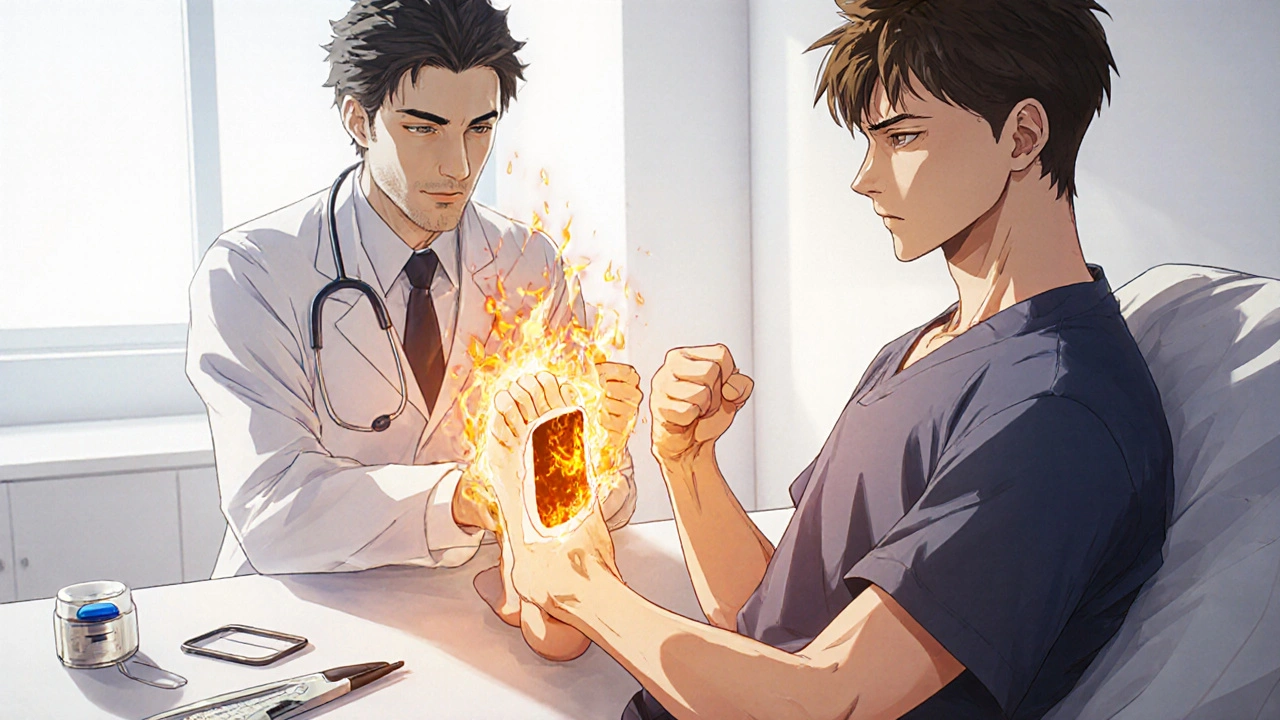
Foot Care Isn’t Optional-It’s Life-Saving
Medications manage pain. Foot care prevents disaster. Diabetic neuropathy doesn’t just hurt-it hides danger. When nerves in your feet are damaged, you lose sensation. You won’t feel a blister, a cut, or a splinter. That small wound can turn into an ulcer. And once an ulcer forms, 1 in 5 people with diabetes will need an amputation within 5 years.
So here’s what you must do every single day:
- Check your feet. Use a mirror or ask someone to look between your toes, on the soles, and around your heels. Look for redness, swelling, cuts, blisters, or changes in skin color.
- Wash your feet daily in lukewarm water. Never soak them. Test the temperature with your elbow-your feet can’t feel if it’s too hot.
- Dry thoroughly, especially between the toes. Moisture invites fungus and infection.
- Apply moisturizer to your feet (not between the toes). Dry skin cracks. Cracks turn into openings for bacteria.
- Wear shoes that fit. No barefoot walking-not even in the house. Even a small step on a hot floor or a sharp object can cause damage you won’t feel until it’s too late.
- Trim toenails straight across. Don’t cut into the corners. Ingrown nails can become infected.
- See your podiatrist or diabetes educator every 6 months. They’ll test your sensation with a 10-gram monofilament. If you can’t feel it, your risk of ulcers goes up.
Special diabetic socks and shoes aren’t luxury items-they’re medical equipment. They’re designed to reduce pressure, prevent friction, and avoid hidden injuries. Medicare and many private insurers cover them if your doctor prescribes them. Ask for a referral.
What to Avoid
Some well-meaning advice is dangerous. Don’t use heating pads or electric blankets on your feet. You can’t feel if you’re burning yourself. Don’t use corn removers or callus scrapers. They’re too sharp. Don’t walk on hot sand or pavement barefoot-even in winter. Don’t ignore a sore, no matter how small. If it doesn’t heal in 2 days, see your doctor.
Also avoid alcohol. It makes nerve damage worse. And don’t delay blood sugar control. The better your A1C, the slower your neuropathy progresses. A 2023 study showed that keeping A1C below 7% slowed nerve damage progression by 60% compared to levels above 8%.
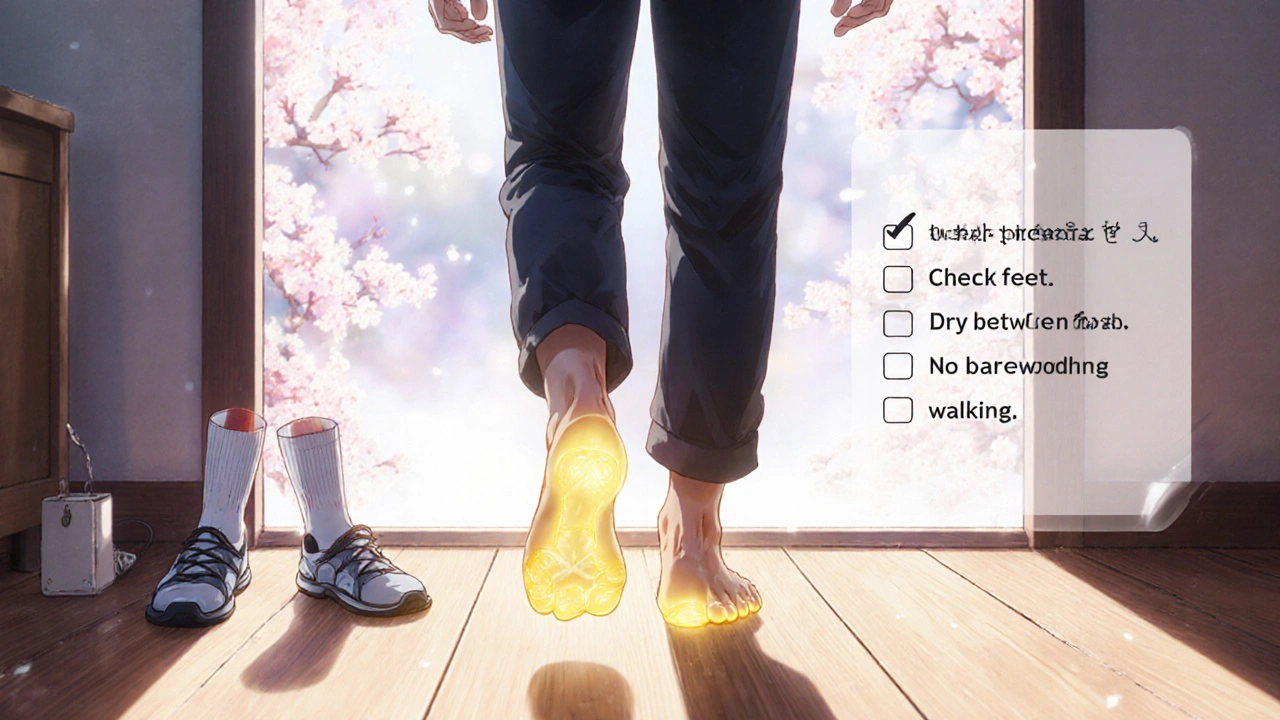
Real Stories, Real Results
One 62-year-old man in Ohio tried gabapentin, then pregabalin, then amitriptyline. None worked. He started duloxetine at 30 mg. After 10 weeks, his pain dropped from an 8/10 to a 3/10. He could finally sleep through the night. He still checks his feet every morning.
A woman in Texas used the capsaicin patch. She cried during the application. But three months later, she walked her granddaughter to school for the first time in years. She says the pain didn’t vanish-but it no longer ruled her life.
And then there’s the man who didn’t check his feet. He got a small cut from a new shoe. He didn’t feel it. Two weeks later, he had a foot ulcer. He lost his toe. He didn’t need to. He just didn’t know.
What’s Next?
The future of diabetic neuropathy treatment is promising. Drugs like mirogabalin are coming. Genetic testing may soon tell you which medication your body will respond to-before you even take it. But none of that matters if you don’t manage your blood sugar and care for your feet.
Right now, your best tools are simple: take your meds as prescribed, check your feet daily, wear protective footwear, and never ignore a change. Pain may not disappear, but it doesn’t have to destroy your life.
Can diabetic neuropathy be reversed?
No, current treatments cannot reverse nerve damage caused by diabetes. The goal of treatment is to slow progression and manage symptoms. Keeping blood sugar under control is the only way to prevent further damage.
What’s the cheapest medication for diabetic neuropathy pain?
Gabapentin is the most affordable option, often costing under $5 for a 90-day supply as a generic. Amitriptyline is also low-cost, typically under $10. Both are effective for many people, though they require careful dosing and monitoring for side effects.
Do I need to see a specialist for diabetic foot care?
Yes. A podiatrist or certified diabetes care and education specialist (CDCES) should examine your feet at least twice a year. They’ll test your sensation, check for ulcers, and recommend proper footwear. Many insurance plans cover these visits under diabetic management programs.
Can I use over-the-counter pain creams for diabetic neuropathy?
Most OTC creams like Bengay or Icy Hot won’t help and can irritate sensitive skin. The only topical option proven to work is the 5% lidocaine patch (Lidoderm), which requires a prescription. Avoid anything with menthol or capsaicin unless it’s the FDA-approved 8% patch applied by a doctor.
How long does it take for neuropathy medications to work?
It varies. Gabapentin and pregabalin may show results in 1-2 weeks, but full effect takes 4-8 weeks. Duloxetine often takes 4-6 weeks. Don’t stop early. Give each medication at least 8 weeks at the right dose before deciding it doesn’t work.
What should I do if my pain gets worse?
If pain increases suddenly or you notice new symptoms like swelling, redness, or open sores on your feet, contact your doctor immediately. Worsening pain could signal an infection, ulcer, or other complication that needs urgent care. Don’t wait.
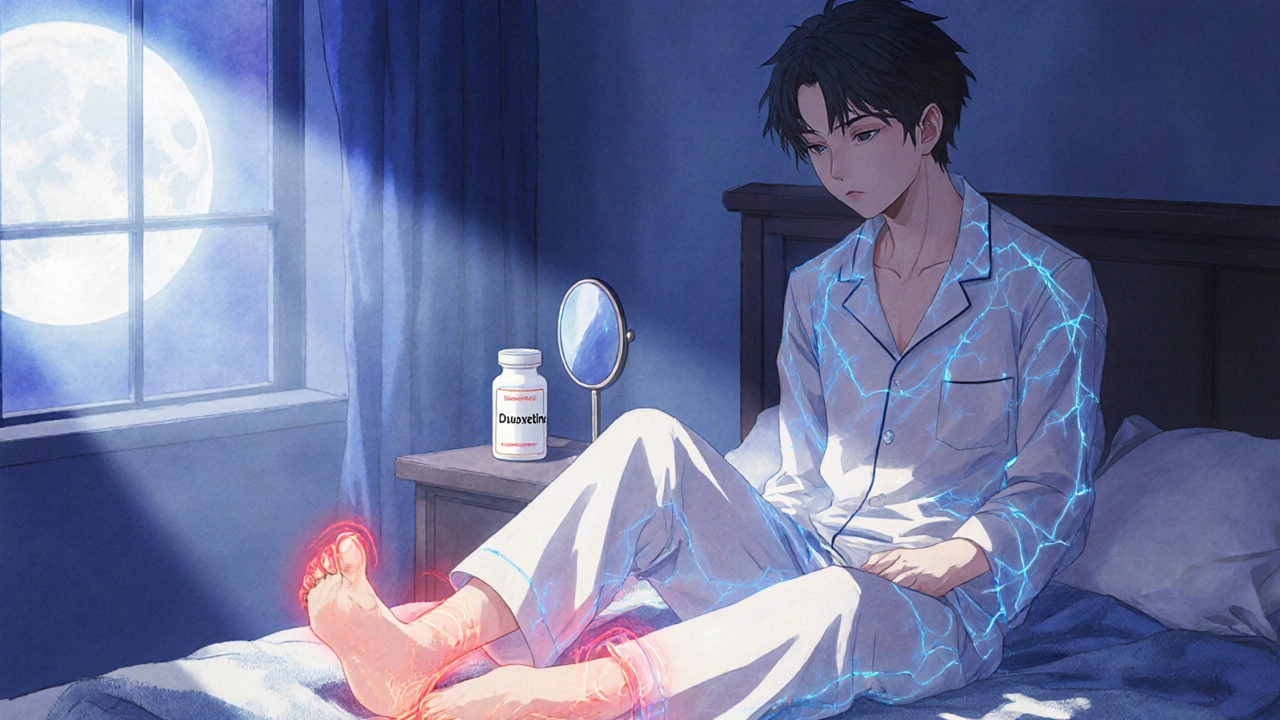
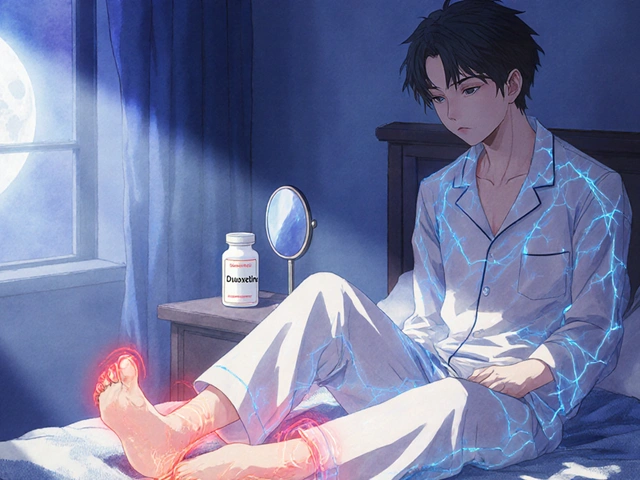



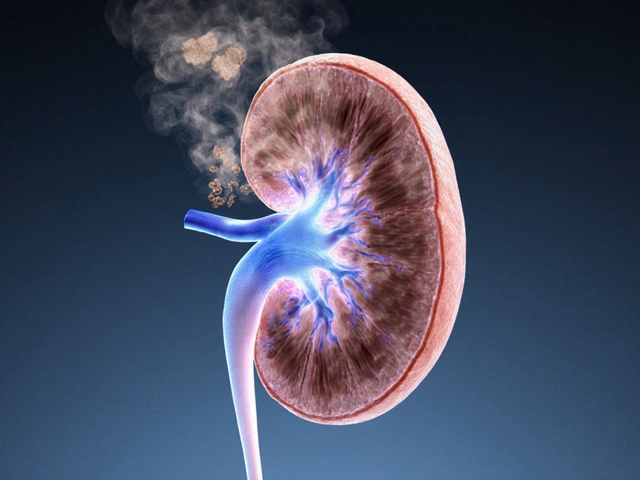

Kevin Wagner
November 13, 2025 AT 07:16Man, I was skeptical about duloxetine until my doc pushed me to try it. Three weeks in, I slept through the night for the first time in two years. Not magic, but it’s the closest thing I’ve found. Still check my feet every morning like clockwork - no excuses. If you’re on the fence, just give it 60 days. Your future self will thank you.
And yeah, gabapentin’s cheap as hell. I got a 90-day supply for $7 at Walmart. Not glamorous, but it works if you don’t mind the brain fog. Just don’t mix it with booze - I learned that the hard way.
gent wood
November 13, 2025 AT 11:32I appreciate the thorough breakdown - especially the part about not using heating pads. I nearly burned myself last winter because I didn’t feel the heat. That’s the silent danger no one talks about. The foot checks, the moisturizer, the shoes - it’s not glamorous, but it’s the difference between walking and wheeling. I’ve been doing this for eight years now. Small habits, big results.
And yes, the capsaicin patch? Painful as hell, but worth it. I cried. My wife cried. Then I walked to the mailbox without limping. That’s worth every second of agony.
Dilip Patel
November 15, 2025 AT 00:54USA always overcomplicate things. In India, we just take gabapentin and turmeric. No fancy patches, no $400 pills. My uncle had neuropathy since 2010 - still walks, still works, no surgery. You don’t need all this Western medicine. Just control sugar, eat right, and stop whining. Also, why are you wearing shoes indoors? Barefoot is natural. Your feet are weak because you coddle them too much.
And lidocaine patch? Too expensive. We use neem oil. Works better. Google it.
Jane Johnson
November 15, 2025 AT 14:00While I appreciate the clinical detail, I must note that the article’s tone is overly optimistic. The notion that pain can be 'cut in half' is statistically misleading. The reality is that most patients experience marginal relief at best, and the side effect profiles of SNRIs and gabapentinoids are often underestimated. Additionally, the emphasis on foot care, while necessary, is not a substitute for systemic management. The article reads more like a marketing piece than a medical advisory.
Also, why is there no mention of ketamine infusions? Or spinal cord stimulators? These are legitimate options for refractory cases, yet they are omitted entirely.
Peter Aultman
November 15, 2025 AT 23:12Just wanna say this is the most real post I’ve read on this topic in years
Been on gabapentin for 18 months. Dose went from 300 to 2400. Still got pain but now I can walk to the fridge without crying. My wife says I smile more. Not because the pain’s gone - but because I finally feel like I’m not just waiting to die.
Foot checks? Daily. Even when I’m tired. Even when I’m drunk. Even when I forget my glasses. I look. I touch. I don’t ignore.
Also - the capsaicin patch? I did it. I screamed. I cried. I hated the doc. Three months later I wore sandals for the first time in five years. Worth it.
Don’t give up. It’s a grind. But you’re not alone.
Sean Hwang
November 16, 2025 AT 17:20My grandma had this and she just used apple cider vinegar soaks and wore cotton socks. No pills. No patches. Just kept her sugar down and checked her feet every night. She lived to 92 and never lost a toe. Maybe we’re overmedicating.
Also - if you’re not checking your feet, you’re playing Russian roulette with your limbs. Simple as that.
Barry Sanders
November 17, 2025 AT 15:47Wow. Another feel-good article that ignores the real issue: diabetes management is the problem, not the pain. You can’t medicate your way out of poor lifestyle choices. If your A1C is above 7%, no pill or patch is going to save your feet. You’re just delaying the inevitable.
And capsaicin? That’s a placebo with a side of torture. People think it’s a miracle because they’re desperate. Not science. Just desperation.
Chris Ashley
November 18, 2025 AT 15:24Wait so you’re telling me I can’t use Icy Hot? But it burns like hell and I feel something for once. Is that bad? I mean, I know I shouldn’t, but it’s the only thing that distracts me from the numbness. Am I the only one who does this?
kshitij pandey
November 19, 2025 AT 10:24From India, I want to say thank you for this post. My brother has diabetic neuropathy and we’ve been lost for years. The part about checking feet daily - we never thought it was that serious. Now we do. We’ve started using coconut oil for moisturizing and he wears socks to bed. Small changes. Big difference.
And gabapentin - yes, it’s cheap here too. We get it for $2 a month. But the real hero? Blood sugar control. No magic pill beats that. Keep your numbers low, and your feet will thank you.
You’re not alone. We’re all fighting the same battle.
Brittany C
November 21, 2025 AT 08:52While the pharmacological overview is accurate, I’d argue that the psychosocial dimension of chronic pain is underrepresented. The emotional burden - the isolation, the loss of autonomy, the grief over lost mobility - is often the most debilitating aspect. Medication and foot care address the somatic, but not the existential. Cognitive behavioral therapy, peer support groups, and narrative medicine interventions should be integrated into standard care protocols. This isn’t just a neurological issue - it’s a human one.
Sean Evans
November 22, 2025 AT 05:29YOU’RE ALL MISSING THE POINT 😤
THEY’RE LYING ABOUT THE COST OF LYRICA. IT’S $379? BRO. I GOT IT FOR $12 ON A MEXICAN WEBSITE. YOU’RE GETTING SCAMMED BY BIG PHARMA. AND THE CAPSAICIN PATCH? THAT’S A $2000 SCAM. I DID IT MYSELF WITH CAYENNE PEPPER AND DUCT TAPE. IT WORKED. I’M A HERO.
AND WHY IS NO ONE TALKING ABOUT THE FACT THAT YOUR DOCTOR IS PROBABLY ON A PAYOFF FROM PFIZER? THEY WANT YOU DEPENDENT. NOT HEALED.
DO YOUR RESEARCH. DON’T TRUST THE SYSTEM. #DIABETESCONSPIRACY
Anjan Patel
November 23, 2025 AT 12:55Look, I’ve been there. I lost my big toe because I didn’t check my feet. I thought it was just a blister. Turns out, it was an infection eating through my flesh. They had to cut it off. I was 43.
Now I check my feet every morning. I wear diabetic socks. I don’t walk barefoot. I take my meds. I don’t drink. I got my A1C down to 6.2.
It’s not about being perfect. It’s about not giving up. One day at a time. One foot at a time.
If you’re reading this and you’re still ignoring your feet - stop. Right now. Look. Touch. Feel. Even if you can’t feel anything - look anyway.
You still have time. I didn’t.
Don’t be me.